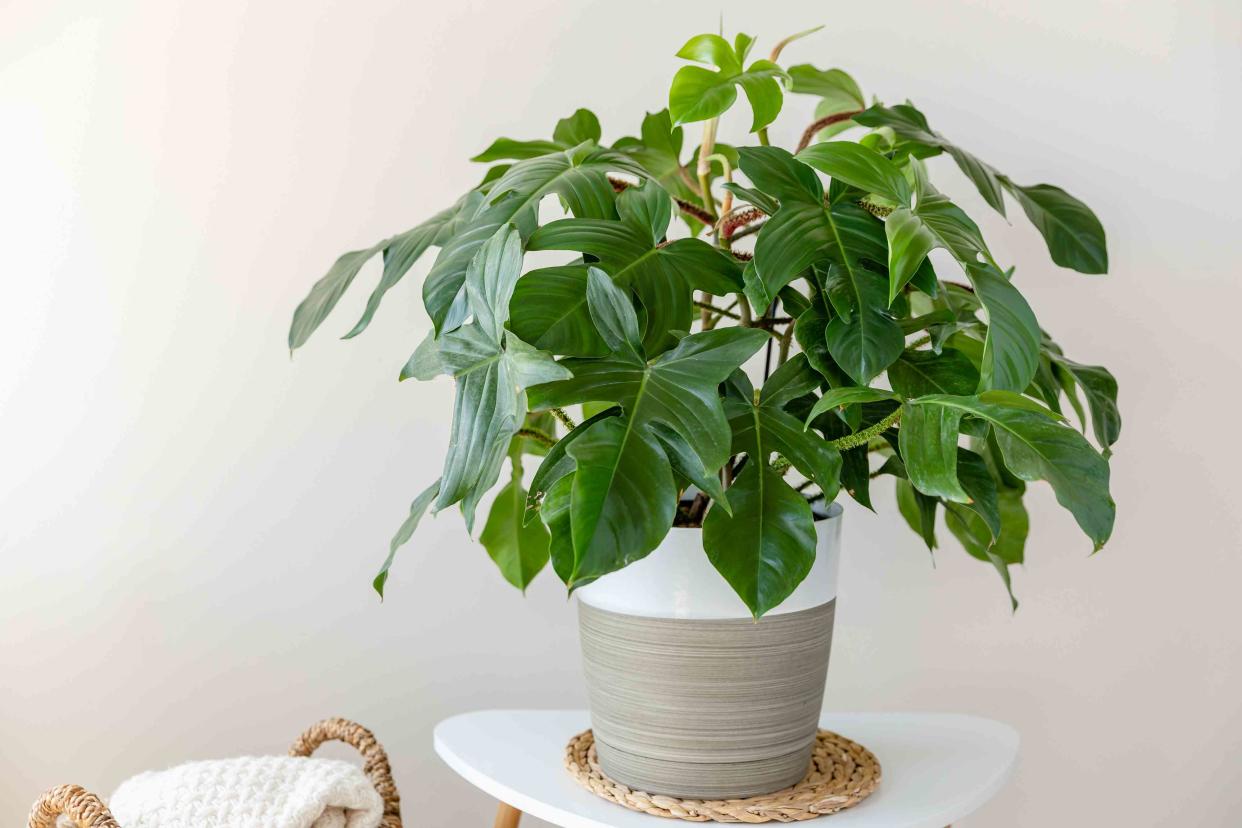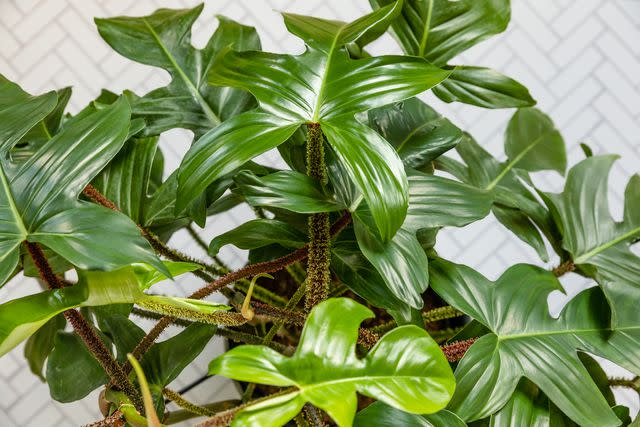How to Grow and Care for Philodendron Squamiferum

The Spruce / Anastasia Tretiak
Reviewed by Kathleen Miller
Philodendron squamiferum has large, dark green foliage with hairy stems that develop a red hue. Its bold, unique leaves stand out among other houseplants. This species prefers bright, indirect light, well-draining soil, regular watering, and high humidity.
Like other Philodendron species, philodendron squamiferum is toxic to pets and people.
Common Name | Philodendron squamiferum |
Botanical Name | Philodendron squamiferum |
Family | Araceae |
Plant Type | Vine, perennial |
Mature Size | 2-15 ft. tall, 1-3 ft. wide |
Sun Exposure | Partial |
Soil Type | Well-drained |
Soil pH | Acidic, neutral |
Hardiness Zones | 9-11 (USDA) |
Native Area | South America, Central America |
Toxicity | Toxic to pets, people |
Philodendron Squamiferum Care
If you find one of these elusive plants, it's a perfect exotic-looking, show-stopping beginner houseplant. Like most philodendron species, it's resilient, versatile, and pretty forgiving of rookie plant care errors. Here are the main care requirements for a philodendron squamiferum:
Plant in well-draining soil, preferably an aroid mix.
Place in bright, indirect light.
Water regularly, but do not let the plant sit in water.
Try to keep humidity around the plant high, ideally above 50 percent.
If desired, provide a trellis, moss pole, or some sort of structure for the plant to climb.
Fertilize lightly during the growing season.

The Spruce / Anastasia Tretiak

The Spruce / Anastasia Tretiak

The Spruce / Anastasia Tretiak

The Spruce / Anastasia Tretiak
Light
As you'd expect of a tropical native commonly found under rainforest tree canopies, philodendron squamiferum does best in bright but indirect light. Too much light will discolor those stunning dark leaves.
Popping your plant within a few feet of an east or west-facing window is typically a perfect position. If you have no choice but to sit them beside a sunny south-facing window, use a sheer curtain to filter the light.
Soil
Philodendron squamiferum is an epiphytic species that can absorb moisture and nourish from aerial roots. Growing in a container, they appreciate a loose, well-drained potting mix. Combining the likes of equal parts orchid bark, perlite, and peaty soil (with some gravel thrown in if needed to up the drainage) is a good blend. Alternatively, there are plenty of ready-made commercial aroid mixes to choose from.
Water
While not wholly drought-tolerant, it's unlikely to be a disaster if you are occasionally a bit tardy with your watering schedule. Overwatering your philodendron squamiferum, however, is a common killer. These plants don't like wet feet, which leads to root rot and pest infestations.
Rather than having a strict schedule, assess when to water your plant by sticking a finger into the soil. It's best to wait until at least the top few inches of soil feel fully dry before watering again.
Temperature and Humidity
It shouldn't be surprising that this tropical native likes higher-than-average indoor humidity levels—dry air isn't this plant's friend. That means you might have to use a humidifier, group alongside plants with similar requirements, or place the container on top of a pebble and water-filled tray.
They're going to do poorly in chilly, drafty rooms too. You want to select a spot where temperatures don't drop too low—ideally between 50 and 75 degrees Fahrenheit.
Fertilizer
The slow-growing philodendron squamiferum isn't a heavy feeder, but fertilizing a couple of times a month during the spring and summer can help to promote large, glossy foliage. Gentle, organic options, like a fish emulsion, work well, or you can try using a diluted water-soluble or slow-release product.
Pruning
While philodendron squamiferum is a slow grower, mature plants can get pretty tall. By pruning or pinching back regularly, you can help keep its form more compact, full, and bushy. Just remove dead or dying leaves if you want a tall, vining plant.
Propagating Philodendron Squamiferum
Part of the popularity of Philodendron species is their ease of propagation. You might have success attempting to grow them from seeds, but sourcing seeds can be challenging, and the process is much longer and more tricky. Consider propagating by stem cuttings:
Use sterile, sharp pruning shears or scissors and take a healthy, mature 3-5 inch stem cutting with at least 4 leaves.
Get rid of the bottom leaves (leaving just 2 or 3 leaves at the top) and ensure there are healthy, exposed nodes at the bottom of the cutting.
Fully submerge the nodes in a clear jar of water or plant in well-draining potting soil in a position with bright, indirect light.
Either change the water every few days or keep the soil moist but not soggy.
Once you see roots around 1 inch long or the cutting stays put when you gently tug it, the roots are sufficiently established for you to repot and treat as you would a mature plant. This typically takes 2 to 4 weeks.
Potting and Repotting Philodendron Squamiferum
Even though the philodendron squamiferum is relatively slow-growing, its vigorous root system will eventually outgrow the pot. Typically you'll need to repot every few years—look out for roots starting to poke out the drainage holes.
Root-bound plants will appreciate being moved to a pot at least a couple of inches wider than the current one. Don't go too big or you risk overwatering and causing root rot because the moisture in the soil won't be absorbed quickly enough.
Common Pests
Thankfully, these easy plants don't suffer from too many diseases, and pests aren't usually a major worry. However, fungus gnats can appear if you are guilty of overwatering. Under-watering and dry conditions can invite spider mites, although spraying with water and wiping away with insecticidal soap or neem oil can nip them in the bud.
Common Problems With Philodendron Squamiferum
Philodendron squamiferum is relatively easy-going if it receives proper care. However, there are a few leaf-related issues you may run into.
Yellow Leaves
Leaving your philodendron squamiferum dry for too long or with wet feet will eventually kill it. But before that happens, yellowing leaves are often your plant's way of telling you to evaluate your watering schedule.
Infestations of common pests, like spider mites, can also result in leaf discoloration, so make sure you tackle them before things get out of control.
Curling Leaves
Curling or droopy leaves tend to indicate your plant needs hydration and that you might need to up your watering schedule. If the leaves start dropping, it could mean the opposite: you are overwatering.
Brown Tips
If the room you keep your philodendron squamiferum in isn't humid enough, one of the first signs that this is a problem is browning, crispy leaf tips. Fungal infections can also cause black or browning tips, so promote good air circulation and try not to splash the foliage when watering.
Frequently Asked Questions
Is philodendron squamiferum rare?
While it might not be the rarest plant in the genus, philodendron squamiferum isn't likely to be one you'll find in your run-of-the-mill plant retailer. You'll need to go to a specialist supplier and expect to pay a premium.
Is philodendron squamiferum a fast grower?
If you're looking for a Philodendron that will fill a tall space in your home quickly, don't pick this one. Philodendron squamiferum is a relatively slow-growing species, although, once mature, it can reach heights of over 10 feet.
Will philodendron squamiferum climb?
Yes, these plants climb in the wild, and they will produce bigger leaves as a houseplant if given the chance to climb and root into some sort of moist medium, such as a moss pole.
Read the original article on The Spruce.

